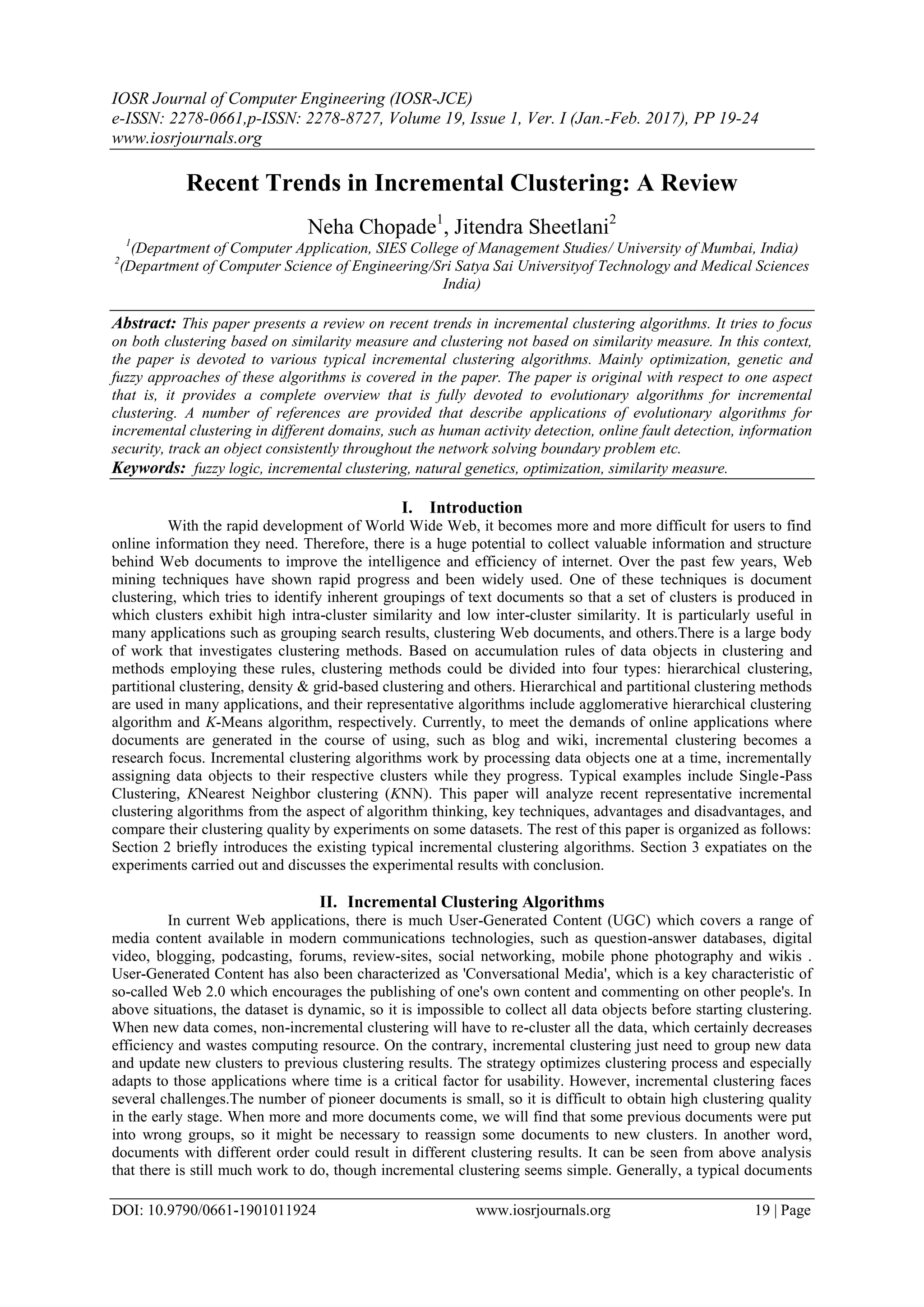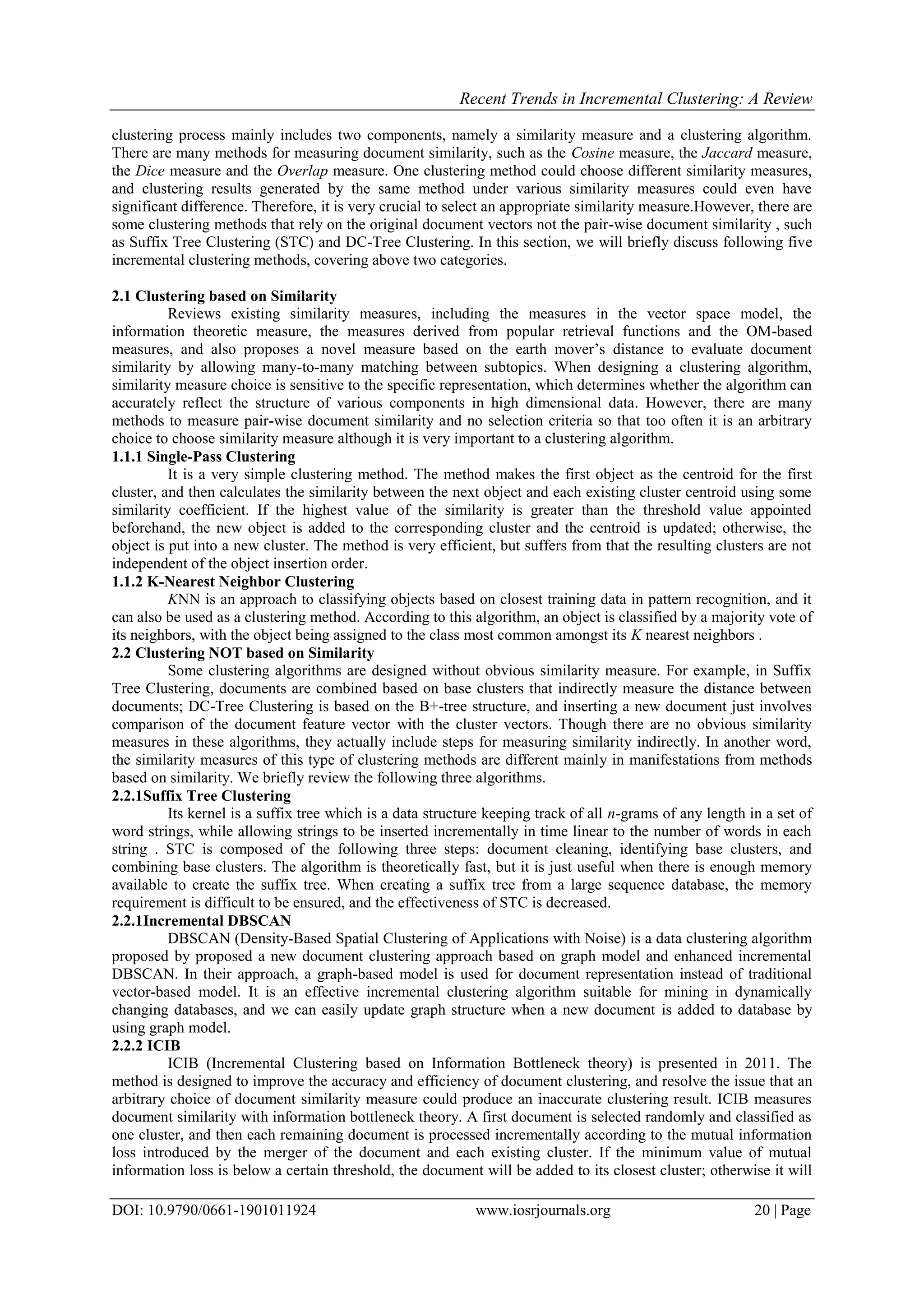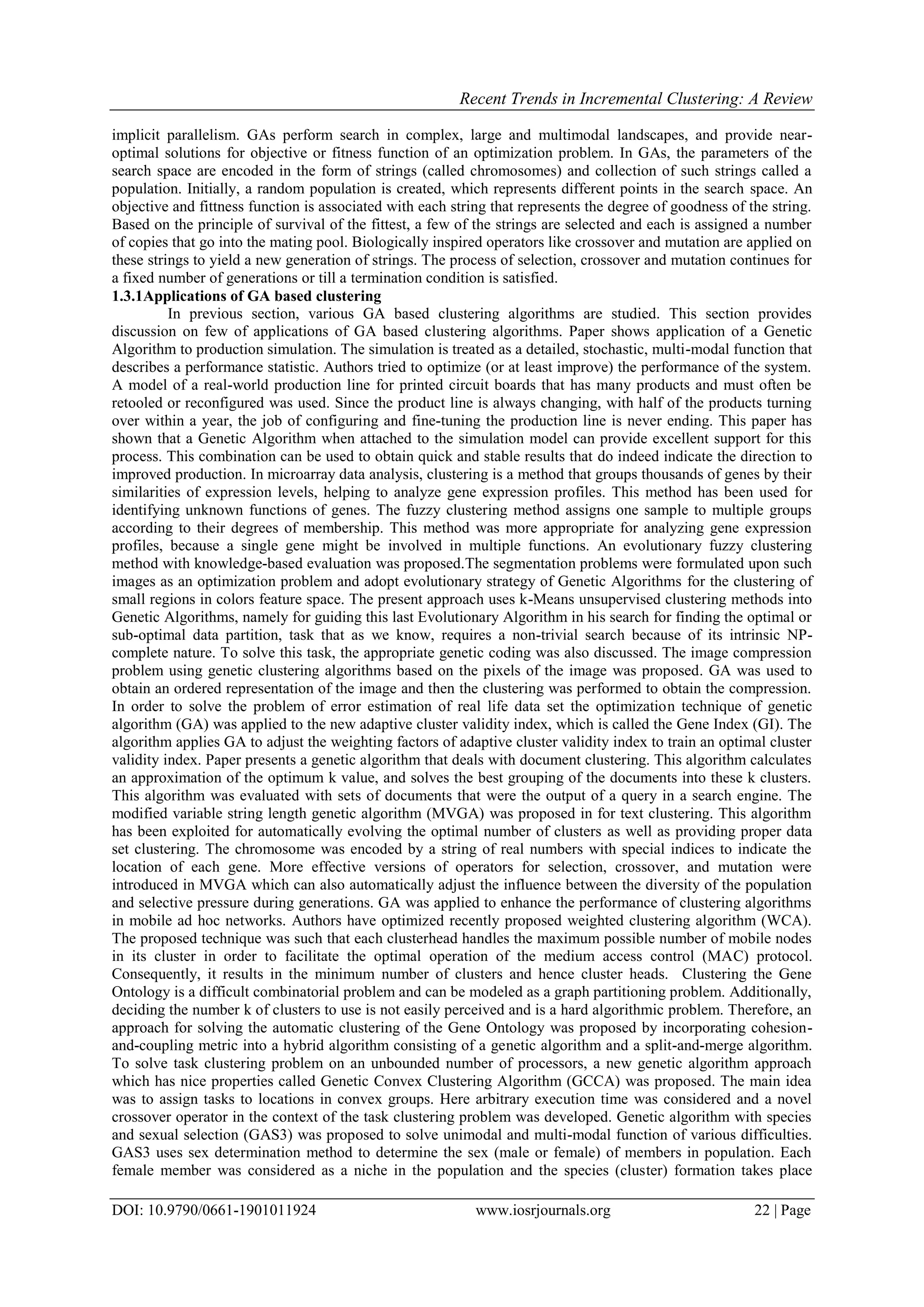This document provides a review of recent trends in incremental clustering algorithms. It discusses clustering methods based on both similarity measures and those not based on similarity measures. Specific incremental clustering algorithms covered include single-pass clustering, k-nearest neighbors clustering, suffix tree clustering, incremental DBSCAN, and ICIB (incremental clustering based on information bottleneck theory). The document also reviews various techniques for clustering, including particle swarm optimization, ant colony optimization, and genetic algorithms. Applications of genetic algorithm based clustering are discussed.


![Recent Trends in Incremental Clustering: A Review
DOI: 10.9790/0661-1901011924 www.iosrjournals.org 21 | Page
be classified as a new cluster. The incremental clustering process is low-precision and order-dependent, which
cannot guarantee accurate clustering results. Therefore, an improved sequential clustering algorithm (SIB ) is
proposed to adjust the intermediate clustering results [1].
III. Various Techniques of Clustering
1.1 Particle Swarm Optimization (PSO)
Particle Swarm Optimization (PSO) was originally designed and introduced by Eberhart and Kennedy.
The PSO is a population based search algorithm based on the simulation of the social behavior of birds, bees or
a school of fishes. PSO originally intends to graphically simulate the graceful and unpredictable choreography
of a bird folk. Each individual within the swarm is represented by a vector in multidimensional search space.
This vector has also one assigned vector which determines the next movement of the particle and is called the
velocity vector.The PSO also determines how to update the velocity of a particle. Each particle updates its
velocity based on current velocity and the best position it has explored so far; and also based on the global best
position explored by swarm. The PSO process then is iterated a fixed number of times or until a minimum error
based on desired performance index is achieved. It has been shown that this simple model can deal with difficult
optimization problems efficiently. The PSO was originally developed for real valued spaces but many problems
are, however, defined for discrete valued spaces where the domain of the variables is finite. Classical examples
of such problems are: integer programming, scheduling and routing. In 1997, Kennedy and Eberhart introduced
a discrete binary version of PSO for discrete optimization problems. In binary PSO, each particle represents its
position in binary values which are 0 or 1. Each particle's value can then be changed (or better say mutate) from
one to zero or vice versa. In binary PSO the velocity of a particle defined as the probability that a particle might
change its state to one. Upon introduction of PSO algorithm, it was used in number of engineering applications.
Using binary PSO, proposed a high quality splitting criterion for codebooks of tree-structured vector quantizers
(TSVQ). Using binary PSO, they reduced the computation time too. Binary PSO is used to train the structure of
a Bayesian network. Although PSO is successfully used in number of engineering applications, but this
algorithm still has some shortcomings. In novel binary PSO, the velocity of a particle is its probability to change
its state from its previous state to its complement value, rather than the probability of change to 1. In this new
definition the velocity of particle and also its parameters has the same role as in real valued version of the PSO.
There are also other versions of binary PSO. authors add birth and mortality to the ordinary PSO. Also fuzzy
system can be used to improve the capability of the binary PSO [2].
1.2 Ant colony optimization
An Ant Colony Optimization algorithm (ACO) is essentially a system based on agents which simulate
the natural behavior of ants, including mechanisms of cooperation and adaptation. The use of this kind of system
as a new metaheuristic was proposed in order to solve combinatorial optimization problems. This new
metaheuristic has been shown to be both robust and versatile – in the sense that it has been successfully applied
to a range of different combinatorial optimization problems. ACO algorithms are based on the following ideas:
Each path followed by an ant is associated with a candidate solution for a given problem. When an ant follows a
path, the amount of pheromone deposited on that path is proportional to the quality of the corresponding
candidate solution for the target problem. When an ant has to choose between two or more paths, the path(s)
with a larger amount of pheromone have a greater probability of being chosen by the ant. As a result, the ants
eventually converge to a short path, hopefully the optimum or a near-optimum solution for the target problem,
as explained before for the case of natural ants. In essence, the design of an ACO algorithm involves the
specification of [2]: An appropriate representation of the problem, which allows the ants to incrementally
construct/modify solutions through the use of a probabilistic transition rule, based on the amount of pheromone
in the trail and on a local, problem-dependent heuristic. A method to enforce the construction of valid solutions,
that is, solutions those are legal in the real-world situation corresponding to the problem definition.A problem-
dependent heuristic function (h) that measures the quality of items that can be added to the current partial
solution. A rule for pheromone updating, which specifies how to modify the pheromone trail (t).A probabilistic
transition rule based on the value of the heuristic function (h) and on the contents of the pheromone trail (t) that
is used to iteratively construct a solution. Artificial ants have several characteristics similar to real ants, namely:
Artificial ants have a probabilistic preference for paths with a larger amount of pheromone. 5 Shorter paths tend
to have larger rates of growth in their amount of pheromone. The ants use an indirect communication system
based on the amount of pheromone deposited on each path [3].
1.3 Genetic algorithm
Genetic algorithms (GAs) are search and optimization procedures that are motivated by the principles
of natural selection and natural genetics. Some fundamental ideas of genetics are borrowed and used artificially
to construct search algorithms that are robust and required minimum problem information. In GAs, the role of
selection and recombination operators is very well defined. Selection operator controls the direction of search
and recombination operator generates new regions for search. Genetic algorithms are having a large amount of](https://image.slidesharecdn.com/d1901011924-170703061829/75/Recent-Trends-in-Incremental-Clustering-A-Review-3-2048.jpg)

![Recent Trends in Incremental Clustering: A Review
DOI: 10.9790/0661-1901011924 www.iosrjournals.org 23 | Page
around these niches. Species formation was based on Euclidean distance between female and male members.
Each species contains one female member and zero or more male members. Parameter-less cluster formation
technique was used. Merging of clusters takes place based on performance evaluation criterion [4].
1.4 Fuzzy Logic
Lets consider an example, a bank wants to classify their customers into two grups as rich and poor
customers. Obviously there is no crisp separation between rich and poor in a way that customers own less than 2
million SEK are poor while they own a fortune of 2million SEK or more are rich. So according to the above
explanation a person with a fortune of 2.1 million SEK is considered as reasonably rich but still a little bit poor.
The indicator for similarity in fuzzy sets is called membership degree µ ={0,.....,1}. A membership degree µ =1
indicates that an object completely belongs to set and a membership degree µ =0 shows a total dissimilarity
between an object and a set. In our example, the customer with 2.1million SEK may have membership degrees
of µ rich 1.2(millionSEK) = 65.0 to the set rich and 1.2(millionSEK) = 35.0 µ poor to the set poor. This indicates
that the customer is rich but not extremely wealthy. However a customer having 30billion SEK would surely
have memberships of 1(billionSEK) = 0.1 µ rich and 0.0 µ poor 1(billionSEK) = o.o. There is probabilistic
uncertainity neither about the fortune of the customer who is having 2.1million SEK nor about the rules for how
to classify him into one or other of the two sets [5].
IV. Related Work and Conclusion
Xizhe Yin et al. [2016] This paper presents our recent work on human activity detection based on smart
phone sensors and incremental clustering algorithms. The proposed unsupervised (clustering) activity detection
scheme works in an incremental manner, which contains two stages. In the first stage, streamed sensor data will
be processed. A single-pass clustering algorithm is used in order to generate pre-clustered results for the next
stage. In the second stage,pre-clustered results will be refined to form the final clusters, which means the
clusters are built incrementally adding one cluster at a time [6].
Ming Hou et al. [2016] In this paper, we present a computationally efficient online tensor regression
algorithm, namely incremental higher-order partial least squares (IHOPLS), for adapting HOPLS to the setting
of infinite time-dependent tensor streams. By incrementally clustering the projected latent variables in latent
space and summarizing the previous data, IHOPLS is able to recursively update the projection matrices and core
tensors over time, resulting in greatly reduced costs in terms of both memory and running time while
maintaining high prediction accuracy. To show the effectiveness and scalability of our approach for large
databases, we apply IHOPLS to two real-life applications as reconstruction of 3D motion trajectories from video
and ECoG streaming signals [7].
Theodora Kontogianni et al. [2016] In this paper, we address the problem of object discovery in time-
varying, large-scale image collections. A core part of our approach is a novel Limited Horizon Minimum
Spanning Tree (LH-MST) structure that closely approximates the Minimum Spanning Tree at a small fraction of
the latter’s computational cost. Our proposed tree structure can be created in a local neighborhood of the
matching graph during image retrieval and can be efficiently updated whenever the image database is extended.
We show how the LH-MST can be used within both single-link hierarchical agglomerative clustering and the
Iconoid Shift framework for object discovery in image collections, resulting in significant efficiency gains and
making both approaches capable of incremental clustering with online updates [8].
Jueun Kwak et al. [2015] In this paper, we propose an online fault detection algorithm based on
incremental clustering. The algorithm accurately finds wafer faults even in severe class distribution skews and
efficiently processes massive sensor data in terms of reductions in the required storage. We tested our algorithm
on illustrative examples and an industrial example. The algorithm performed well with the illustrative examples
that included imbalanced class distributions of Gaussian and non Gaussian types and process drifts. In the
industrial example, which simulated real data from a plasma etcher, we verified that the performance of the
algorithm was better than that of the standard support vector machine (SVM), one-class SVM and three
instance-based fault detection algorithms that are typically used in the literature. Most standard classification
algorithms, such as support vector machines, can handle moderate sizes of training data and assume balanced
class distributions. When the class sizes are highly imbalanced, the standard algorithms tend to strongly favor
the majority class and provide a notably low detection of the minority class as a result [9].
Mahmuda Akter et al. [2015] In this paper, an Incremental Clustering Algorithm is proposed in
conjunction with Static Clustering Technique to track an object consistently throughout the network solving
boundary problem. The proposed research follows a Gaussian Adaptive Resonance Theory (GART) based
Incremental Clustering that creates and updates clusters incrementally to incorporate incessant motion pattern
without defiling the previously learned clusters. The objective of this research is to continue tracking at the
boundary region in an energy-efficient way as well as to ensure robust and consistent object tracking throughout
the network. The network lifetime performance metric has shown significant improvements for Incremental
Static Clustering at the boundary regions than that of existing clustering techniques. Emerging significance of](https://image.slidesharecdn.com/d1901011924-170703061829/75/Recent-Trends-in-Incremental-Clustering-A-Review-5-2048.jpg)
![Recent Trends in Incremental Clustering: A Review
DOI: 10.9790/0661-1901011924 www.iosrjournals.org 24 | Page
moving object tracking has been actively pursued in the Wireless Sensor Network (WSN) community for the
past decade. As a consequence, a number of methods from different angle of assessment have been developed
while relatively satisfying performance. Amongst those, clustering based object tracking has shown significant
results, which in term provides the network to be scalable and energy efficient for large-scale WSNs. As of now,
static cluster based object tracking is the most common approach for large-scale WSN. However, as static
clusters are restricted to share information globally, tracking can be lost at the boundary region of static clusters
[10].Teena Ajayan et al. [2015] in this paper, the key idea is to find multiple representative sequences like
medoids to represent a cluster in a chunk and final DNA analysis is carried out based on those identified
medoids from all the chunks. The main advantage of this incremental clustering is that it uses multiple medoids
to represent each cluster in each chunk which captures the pattern structure more accurately. Not only that it
overcomes the disadvantages of existing techniques but also has the mechanism to make use of DNA sequence
relationship among those identified medoids that serves as a side information to help the final DNA sequence
clustering. The proposed incremental approach outperforms existing clustering approaches in terms of clustering
accuracy [11].
Jafar Boostanpour et al. [2015] In this paper, to overcome the aforementioned obstacles, a two-step
algorithm is proposed which in first step, a fast spherical interpolation (SI) method is utilized to prepare an
appropriate initial guess for the MLE algorithm. In the second step, a clustering-based network is described to
attain less power consumption across the WSN. Furthermore, to increase the probability of convergence, a
cooperative incremental clusterbased estimation strategy is proposed. In addition, major issues that can affect
the performance of the proposed method are investigated. Simulation results prove the capability of this method
and support the claims [12]. Puma Chandra Sethi et al. [2014] In this paper, EHMA is implemented in two tiers,
but this paper considers the implementation of EHMA in three tiers. It follows incremental clustering algorithm
for grouping clusters according to their impact factors. This three tier implementation of EHMA improves the
security of the information as it uses SHA-256 for security. - In the present scenario, most of the computing
operations are performed over the Internet. Many companies provide their services using Internet, so networking
services becomes more important these days. Hence, there is high demand for secured management of
information, along with faster processing of operations. Due to increased demand for network services, there is a
need to increase the performance of these services [13].
References
[1]. Yongli Liu, Qianqian Guo, Lishen Yang, Yingying Li “Research on Incremental Clustering” 978-1-4577-1415-3/12/$26.00 ©2012
IEEE.
[2]. Amreen Khan, Prof. Dr. N.G.Bawane, Prof. Sonali Bodkhe “An Analysis of Particle Swarm Optimization with Data Clustering-
Technique for Optimization in Data Mining.” International Journal on Computer Science and Engineering Vol. 02, No. 04, 2010,
1363-1366.
[3]. Rafael S. Parpinelli, Heitor S. Lopes, and Alex A. Freitas “Data Mining with an Ant Colony Optimization Algorithm”2010.
[4]. Rahila H. Sheikh, M. M.Raghuwanshi, Anil N. Jaiswal “Genetic Algorithm Based Clustering: A Survey” First International
Conference on Emerging Trends in Engineering and Technology, 2008 IEEE.
[5]. Md. Ehsanul Karim Feng Yun Sri Phani Venkata Siva Krishna Madani “Fuzzy Clustering Analysis” April 2010.
[6]. Xizhe Yin, Weiming Shen, Xianbin Wang “Incremental Clustering for Human Activity Detection Based on Phone Sensor Data”
2016 IEEE.
[7]. Ming Hou, Brahim Chaib-draa “ONLINE INCREMENTAL HIGHER-ORDER PARTIAL LEAST SQUARES REGRESSION
FOR FAST RECONSTRUCTION OF MOTION TRAJECTORIES FROM TENSOR STREAMS”2016 IEEE.
[8]. Theodora Kontogianni, Markus Mathias, Bastian Leibe “Incremental Object Discovery in Time-Varying Image Collections” 2016
IEEE.
[9]. Jueun Kwak, Taehyung Lee and Chang Ouk Kim “An Incremental Clustering-Based Fault Detection Algorithm for Class-
Imbalanced Process Data”, IEEE TRANSACTIONS ON SEMICONDUCTOR MANUFACTURING, VOL. 28, NO. 3 , 2015
IEEE.
[10]. Mahmuda Akter, Md. Obaidur Rahman, Md. Nazrul Islam and Md. Ahsan Habib “Incremental Clustering-based Object Tracking in
Wireless Sensor Networks” 2015 IEEE.
[11]. Teena Ajayan, Sony P, Janu R Panicker, Shailesh S “Clustering DNA Sequences Of Aspergillus fumigatus Using Incremental
Multiple Medoids” 2015 IEEE Fifth International Conference on Advances in Computing and Communications.
[12]. Jafar Boostanpour, Sayed Mostafa Taheri, Hossein Zamiri-Jafarian “Cluster-Based Two-Step Target Localization with Incremental
Cooperation” 2015 IEEE.
[13]. Puma Chandra Sethi, Prafulla Kumar Behera “Secured Packet Inspection with Hierarchical Pattern Matching implemented using
Incremental Clustering Algorithm” 978-1-4799-5958-7/14/$31.00 ©20 14 IEEE.](https://image.slidesharecdn.com/d1901011924-170703061829/75/Recent-Trends-in-Incremental-Clustering-A-Review-6-2048.jpg)